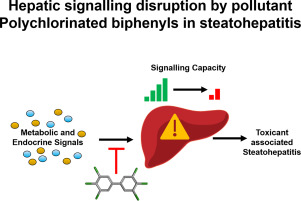当前位置:
X-MOL 学术
›
Cell. Signal.
›
论文详情
Our official English website, www.x-mol.net, welcomes your
feedback! (Note: you will need to create a separate account there.)
Hepatic signalling disruption by pollutant Polychlorinated biphenyls in steatohepatitis.
Cellular Signalling ( IF 4.4 ) Pub Date : 2018-10-06 , DOI: 10.1016/j.cellsig.2018.10.004 Josiah E Hardesty 1 , Banrida Wahlang 2 , K Cameron Falkner 3 , Hongxue Shi 4 , Jian Jin 4 , Daniel Wilkey 5 , Michael Merchant 5 , Corey Watson 1 , Russell A Prough 1 , Matthew C Cave 6
Cellular Signalling ( IF 4.4 ) Pub Date : 2018-10-06 , DOI: 10.1016/j.cellsig.2018.10.004 Josiah E Hardesty 1 , Banrida Wahlang 2 , K Cameron Falkner 3 , Hongxue Shi 4 , Jian Jin 4 , Daniel Wilkey 5 , Michael Merchant 5 , Corey Watson 1 , Russell A Prough 1 , Matthew C Cave 6
Affiliation

|
BACKGROUND
Polychlorinated biphenyl-mediated steatohepatitis has been shown to be due in part to inhibition of epidermal growth factor receptor (EGFR) signalling. EGFR signalling regulates many facets of hepatocyte function, but it is unclear which other kinases and pathways are involved in the development of toxicant-associated steatohepatitis (TASH).
METHODS
Comparative hepatic phosphoproteomic analysis was used to identify which kinases were affected by either PCB exposure (Aroclor 1260 mixture), high fat diet (HFD), or their interaction in a chronic exposure model of TASH. Cellular assays and western blot analysis were used to validate the phosphoproteomic findings.
RESULTS
1760 unique phosphorylated peptides were identified and of those 588 were significantly different. PCB exposure and dietary interaction promoted a near 25% reduction of hepatic phospho-peptides. Leptin and insulin signalling were pathways highly affected by PCB exposure and liver necrosis was a pathologic ontology over represented due to interaction between PCBs and a HFD. Casein kinase 2 (CK2), Extracellular regulated kinase (ERK), Protein kinase B (AKT), and Cyclin dependent kinase (CDK) activity were demonstrated to be downregulated after PCB exposure and this downregulation was exacerbated with a HFD. PCB exposure led to a loss of hepatic CK2 subunit expression limiting CK2 kinase activity and negatively regulating caspase-3 (CASP3). PCBs promoted secondary necrosis in vitro validating the latter observation. The loss of hepatic phosphoprotein signalling appeared to be due to decreased signal transduction rather than phosphatase upregulation.
CONCLUSIONS
PCBs are signal disrupting chemicals that promote secondary necrosis through affecting a myriad of liver processes including metabolism and cellular maintenance. PCB exposure, particularly with interaction with a HFD greatly down-regulates the hepatic kinome. More data are needed on signalling disruption and its impact on liver health.
中文翻译:

脂肪性肝炎中污染物多氯联苯对肝脏信号的干扰。
背景技术已证明多氯联苯介导的脂肪性肝炎部分是由于表皮生长因子受体(EGFR)信号传导的抑制所致。 EGFR 信号传导调节肝细胞功能的许多方面,但尚不清楚哪些其他激酶和途径参与毒物相关脂肪性肝炎 (TASH) 的发展。方法 使用比较肝磷酸化蛋白质组学分析来确定哪些激酶受到 PCB 暴露(Aroclor 1260 混合物)、高脂肪饮食 (HFD) 或它们在 TASH 慢性暴露模型中相互作用的影响。使用细胞测定和蛋白质印迹分析来验证磷酸化蛋白质组学结果。结果 鉴定出 1760 种独特的磷酸化肽,其中 588 种存在显着差异。 PCB 暴露和饮食相互作用促使肝磷酸肽减少近 25%。瘦素和胰岛素信号传导是受 PCB 暴露高度影响的途径,而肝坏死是由于 PCB 和 HFD 之间的相互作用而过度代表的病理学本体。事实证明,酪蛋白激酶 2 (CK2)、细胞外调节激酶 (ERK)、蛋白激酶 B (AKT) 和细胞周期蛋白依赖性激酶 (CDK) 活性在 PCB 暴露后下调,并且 HFD 会加剧这种下调。 PCB 暴露导致肝脏 CK2 亚基表达丧失,限制 CK2 激酶活性并负向调节 caspase-3 (CASP3)。 PCB 在体外促进继发性坏死,验证了后一个观察结果。肝磷蛋白信号传导的丧失似乎是由于信号转导减少而不是磷酸酶上调所致。 结论 PCB 是信号干扰化学物质,通过影响包括代谢和细胞维持在内的多种肝脏过程来促进继发性坏死。 PCB 暴露,特别是与 HFD 相互作用,会极大地下调肝激酶组。需要更多关于信号干扰及其对肝脏健康影响的数据。
更新日期:2018-10-06
中文翻译:

脂肪性肝炎中污染物多氯联苯对肝脏信号的干扰。
背景技术已证明多氯联苯介导的脂肪性肝炎部分是由于表皮生长因子受体(EGFR)信号传导的抑制所致。 EGFR 信号传导调节肝细胞功能的许多方面,但尚不清楚哪些其他激酶和途径参与毒物相关脂肪性肝炎 (TASH) 的发展。方法 使用比较肝磷酸化蛋白质组学分析来确定哪些激酶受到 PCB 暴露(Aroclor 1260 混合物)、高脂肪饮食 (HFD) 或它们在 TASH 慢性暴露模型中相互作用的影响。使用细胞测定和蛋白质印迹分析来验证磷酸化蛋白质组学结果。结果 鉴定出 1760 种独特的磷酸化肽,其中 588 种存在显着差异。 PCB 暴露和饮食相互作用促使肝磷酸肽减少近 25%。瘦素和胰岛素信号传导是受 PCB 暴露高度影响的途径,而肝坏死是由于 PCB 和 HFD 之间的相互作用而过度代表的病理学本体。事实证明,酪蛋白激酶 2 (CK2)、细胞外调节激酶 (ERK)、蛋白激酶 B (AKT) 和细胞周期蛋白依赖性激酶 (CDK) 活性在 PCB 暴露后下调,并且 HFD 会加剧这种下调。 PCB 暴露导致肝脏 CK2 亚基表达丧失,限制 CK2 激酶活性并负向调节 caspase-3 (CASP3)。 PCB 在体外促进继发性坏死,验证了后一个观察结果。肝磷蛋白信号传导的丧失似乎是由于信号转导减少而不是磷酸酶上调所致。 结论 PCB 是信号干扰化学物质,通过影响包括代谢和细胞维持在内的多种肝脏过程来促进继发性坏死。 PCB 暴露,特别是与 HFD 相互作用,会极大地下调肝激酶组。需要更多关于信号干扰及其对肝脏健康影响的数据。











































 京公网安备 11010802027423号
京公网安备 11010802027423号